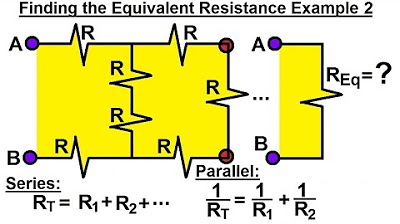Electrical Engineering: Basic Laws (14 of 31) Parallel Resistors and Current Division
Summary
TLDRThis video explains the concept of a parallel circuit, focusing on how resistors act as a current divider. It demonstrates how the total current is split between two resistors in parallel and how the current distribution depends on their resistances. Using Ohm's law, the video calculates the total resistance and current for a simple circuit. The presenter further explains how to determine the current in each branch by multiplying the total current by the ratio of the other branch's resistance to the sum of both resistors. This is known as the current divider rule.
Takeaways
- ⚡ In a parallel circuit, the current splits at a node, dividing into two branches, each with its own current (I1 and I2).
- 🔌 The current from the source splits into two branches based on the resistors in the circuit.
- 🔍 The total resistance (R total) in a parallel circuit is always less than the smallest individual resistor.
- 📐 The formula for total resistance in a parallel circuit is 1/R total = 1/R1 + 1/R2, which can be simplified for two resistors to R total = (R1 * R2) / (R1 + R2).
- 🧮 In the example provided, with R1 = 6 ohms and R2 = 4 ohms, the total resistance is calculated as 2.4 ohms.
- ⚙️ Using Ohm’s law (I = V/R), the total current leaving the voltage source is calculated as 0.833 amps with a voltage of 20 volts and a resistance of 2.4 ohms.
- 🔀 The current in each branch is found by multiplying the total current by the ratio of the resistance in the other branch to the sum of the two resistors.
- 📊 In the first branch, I1 is calculated as 0.333 amps, and in the second branch, I2 is 0.5 amps.
- ⚖️ The sum of currents in both branches equals the total current, confirming the calculations (0.333 + 0.5 = 0.833 amps).
- 🛠️ The current divider rule helps determine the current in each branch by considering the resistances in the parallel circuit.
Q & A
What is a parallel circuit?
-A parallel circuit is a type of electrical circuit where two or more components (such as resistors) are connected side by side, and the current is divided between them, with each component receiving a portion of the total current.
How does current split in a parallel circuit?
-In a parallel circuit, the total current from the voltage source splits at a node, with one part of the current going through one branch and the other part going through the other branch. The current in each branch depends on the resistance of that branch.
How do you calculate the total resistance (R total) in a parallel circuit?
-The total resistance in a parallel circuit is calculated using the formula: 1/R total = 1/R1 + 1/R2. For two resistors, it can be simplified to R total = (R1 * R2) / (R1 + R2).
What is the total resistance when R1 is 6 ohms and R2 is 4 ohms?
-Using the formula for total resistance in a parallel circuit: R total = (6 * 4) / (6 + 4) = 24 / 10 = 2.4 ohms.
How do you calculate the total current in a parallel circuit?
-The total current can be calculated using Ohm's law: I = V / R total. For example, if the voltage is 20V and R total is 2.4 ohms, then I = 20V / 2.4 ohms = 0.833 amps.
How is the current distributed in each branch of a parallel circuit?
-The current in each branch is distributed according to the ratio of the resistances. The current in one branch is equal to the total current multiplied by the ratio of the resistance in the other branch divided by the sum of the resistances.
How do you calculate the current in the first branch (I1) in a parallel circuit?
-To calculate the current in the first branch, use the formula: I1 = I total * (R2 / (R1 + R2)). For example, if I total = 0.833 amps, R1 = 6 ohms, and R2 = 4 ohms, I1 = 0.833 * (4 / (6 + 4)) = 0.333 amps.
How do you calculate the current in the second branch (I2) in a parallel circuit?
-To calculate the current in the second branch, use the formula: I2 = I total * (R1 / (R1 + R2)). For example, if I total = 0.833 amps, R1 = 6 ohms, and R2 = 4 ohms, I2 = 0.833 * (6 / (6 + 4)) = 0.5 amps.
Why does the smaller resistor receive more current in a parallel circuit?
-In a parallel circuit, the branch with the smaller resistance receives more current because the current follows the path of least resistance. The smaller the resistance, the larger the portion of the total current that flows through that branch.
What is the purpose of using a current divider in a parallel circuit?
-The current divider helps in distributing the total current between the branches of the parallel circuit according to the ratio of the resistances in each branch, allowing for precise control of how much current each branch receives.
Outlines

This section is available to paid users only. Please upgrade to access this part.
Upgrade NowMindmap

This section is available to paid users only. Please upgrade to access this part.
Upgrade NowKeywords

This section is available to paid users only. Please upgrade to access this part.
Upgrade NowHighlights

This section is available to paid users only. Please upgrade to access this part.
Upgrade NowTranscripts

This section is available to paid users only. Please upgrade to access this part.
Upgrade NowBrowse More Related Video

TEI3B2 - Elektronika B - Analisis DC BJT - Voltage Divider

Listrik Dinamis-Rangkaian Listrik (Hukum Ohm) (Part 3)

Clipper Circuits | Diode | Diode theory & applications |Basics Electronics

Simple Circuits | Electricity | Physics | FuseSchool

Video Pembelajaran Modul 4 & 5 Praktikum Rangkaian Listrik 2024/2025 (FH)

Electrical Engineering: Basic Laws (17 of 31) Finding the Equivalent Resistor Ex. 2
5.0 / 5 (0 votes)